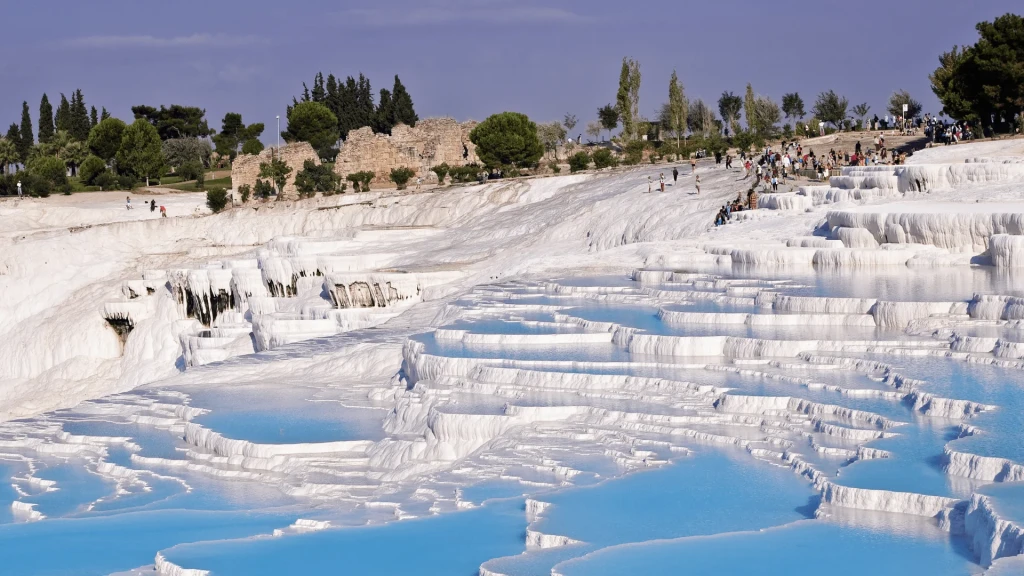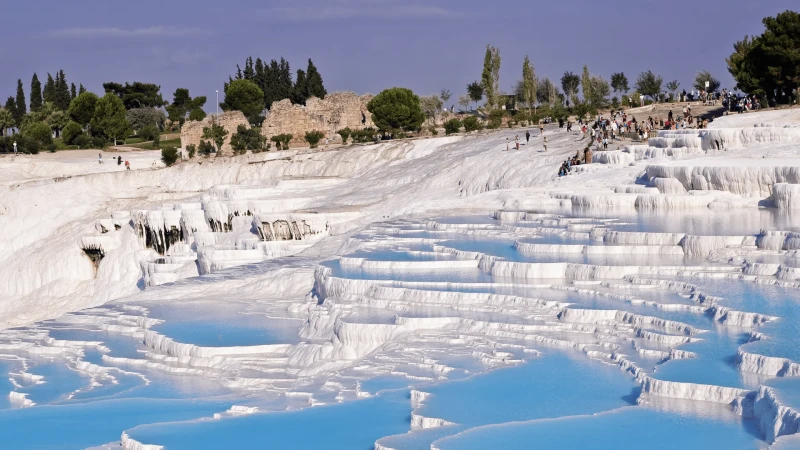Pamukkale Travertines – Cotton Castle & Visitor Guide

Pamukkale Travertines – Cotton Castle of Turkey
Introduction
The Pamukkale Travertines (Pamukkale Travertenleri), often called the “Cotton Castle”, are one of Turkey’s most iconic natural wonders. Located in Denizli province, Pamukkale is famous for its dazzling white terraces of calcium carbonate, formed by thermal spring waters cascading down the hillside for thousands of years.
Recognized as a UNESCO World Heritage Site, Pamukkale combines natural beauty and ancient history, as it lies next to the ancient city of Hierapolis, creating one of the world’s most unique archaeological-natural landscapes.
📍 Related Read: Cappadocia Travel Guide – Explore Turkey’s Fairytale Land
How Pamukkale Travertines Were Formed
- The travertines are created by thermal waters rich in calcium bicarbonate.
- When the hot spring water flows down the slopes, the carbon dioxide evaporates, leaving behind white calcium deposits.
- Over centuries, this process created the spectacular terraces, pools, and stalactites seen today.
History and UNESCO Heritage
- Pamukkale has been a spa and healing center for over 2,000 years.
- The nearby ancient city of Hierapolis was founded in the 2nd century BC by the Pergamon Kingdom.
- Romans developed it into a major thermal spa destination.
- In 1988, Pamukkale and Hierapolis were jointly inscribed as a UNESCO World Heritage Site for their outstanding cultural and natural significance.
🔗 External Source: UNESCO – Pamukkale and Hierapolis
📍 Related Read: Pamukkale Travel Guide – Cotton Castle & Hierapolis
Things to See and Do at Pamukkale
🏞️ Walk on the Travertines
- Visitors can walk barefoot along designated areas of the terraces.
- Swimming in some pools is allowed, but access is restricted to protect the site.
🏛️ Explore Hierapolis Ancient City
- Theatre: A grand Roman theatre with a capacity of 12,000.
- Necropolis: One of the largest ancient cemeteries in Turkey.
- Temple of Apollo & Plutonium: Sacred sites linked to ancient cults.
💧 Cleopatra’s Pool (Antique Pool)
- A thermal pool where legend says Cleopatra once swam.
- Filled with ancient marble columns and ruins submerged in warm mineral water.
🌅 Sunset over Pamukkale
- The white terraces glowing in orange and pink hues at sunset offer breathtaking photography opportunities.
📍 Related Read: Aspendos Ancient Theatre – Roman Acoustics & History
Visiting Pamukkale Today
📍 Location
- Denizli Province, southwestern Turkey.
🕒 Opening Hours
- Summer: 06:30 – 21:00
- Winter: 08:00 – 18:00
🎟️ Entrance Fee
- Around 700 TL (~€20) including access to Hierapolis.
- Cleopatra’s Pool requires an extra ticket (~200 TL).
🔗 External Source: GoTürkiye – Pamukkale
🚍 How to Get There
- By air: Denizli Çardak Airport (1 hr from Pamukkale).
- By bus/train: From major cities like Istanbul, Izmir, Antalya.
- Guided tours: Many packages include Pamukkale + Hierapolis + Aphrodisias.
📍 Related Tour: 6-Day Western Turkey Tour – Istanbul, Gallipoli, Ephesus & Pamukkale
Travel Tips
- Walk barefoot – shoes are not allowed on the terraces.
- Bring swimwear if you want to enter Cleopatra’s Pool.
- Visit early morning or sunset to avoid crowds.
- Combine Pamukkale with nearby attractions like Laodicea and Aphrodisias.
- Stay overnight in Pamukkale village or Denizli to enjoy the site without rushing.
📍 Related Read: Kaleiçi Antalya – Old Town Visitor Guide
Why Visit Pamukkale Travertines?
- A rare natural wonder + archaeological site combination.
- Iconic white terraces and turquoise pools.
- Healing hot springs known since Roman times.
- UNESCO World Heritage status.
- One of the most photographed landmarks in Turkey.
📍 Related Read: Olympos & Cirali – Ancient Ruins and Tranquil Beaches
SEO Optimized FAQ – Pamukkale
1. Where is Pamukkale located?
In Denizli Province, southwestern Turkey.
2. What is Pamukkale famous for?
White travertine terraces, hot springs, and the ancient city of Hierapolis.
3. Is Pamukkale a UNESCO site?
Yes, Pamukkale and Hierapolis were inscribed in 1988.
4. Can you swim in Pamukkale?
Yes, in designated pools and Cleopatra’s Pool.
5. How much is the entrance fee?
Around 700 TL (~€20).
6. What is Cleopatra’s Pool?
A thermal pool with submerged ancient columns, linked to Cleopatra.
7. Best time to visit Pamukkale?
Spring and autumn for mild weather.
8. How long to spend in Pamukkale?
At least half a day; a full day if combined with Hierapolis.
9. Can I visit Pamukkale in a day trip?
Yes, from Izmir, Antalya, Kusadasi, or Fethiye.
10. Why is Pamukkale called Cotton Castle?
Because the terraces resemble fluffy white cotton.
Conclusion
The Pamukkale Travertines are one of the most extraordinary natural wonders in the world. With their white cascading terraces, ancient spa culture, and UNESCO recognition, they represent a unique blend of nature and history.
Whether you want to walk on the terraces, swim in Cleopatra’s Pool, or explore the ruins of Hierapolis, Pamukkale is a must-see destination in Turkey.
For a complete journey, combine Pamukkale with Cappadocia’s hot air balloons, Antalya’s beaches, and Istanbul’s historic landmarks.
📍 Related Experience: Pamukkale to Cappadocia Private Transfer













